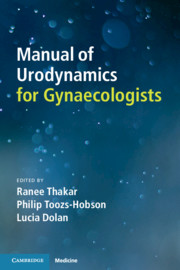Book contents
- Manual of Urodynamics for Gynaecologists
- Additional material
- Manual of Urodynamics for Gynaecologists
- Copyright page
- Contents
- Contributors
- Preface
- Preface to Urodynamics Illustrated
- Chapter 1 Pre-test Assessment of Urinary Dysfunction, Using Patient-Centred Questionnaires
- Chapter 2 The Assessment of Women with Lower Urinary Tract Dysfunction, Using Bladder Diaries
- Chapter 3 Pad Testing in the Assessment of Urinary Incontinence in Women
- Chapter 4 Setting Up the Urodynamic Equipment
- Chapter 5 Urodynamic Flow Rate Testing
- Chapter 6 The Cystometrogram
- Chapter 7 Videocystourethrography
- Chapter 8 Ambulatory Urodynamic Monitoring
- Chapter 9 Urodynamic Artefacts
- Chapter 10 The Assessment of Urethral Function
- Chapter 11 Urodynamics in the Neurological Patient
- Chapter 12 Urodynamic Terminology
- Index
- References
Chapter 10 - The Assessment of Urethral Function
Supplementary Investigations
Published online by Cambridge University Press: 10 April 2020
- Manual of Urodynamics for Gynaecologists
- Additional material
- Manual of Urodynamics for Gynaecologists
- Copyright page
- Contents
- Contributors
- Preface
- Preface to Urodynamics Illustrated
- Chapter 1 Pre-test Assessment of Urinary Dysfunction, Using Patient-Centred Questionnaires
- Chapter 2 The Assessment of Women with Lower Urinary Tract Dysfunction, Using Bladder Diaries
- Chapter 3 Pad Testing in the Assessment of Urinary Incontinence in Women
- Chapter 4 Setting Up the Urodynamic Equipment
- Chapter 5 Urodynamic Flow Rate Testing
- Chapter 6 The Cystometrogram
- Chapter 7 Videocystourethrography
- Chapter 8 Ambulatory Urodynamic Monitoring
- Chapter 9 Urodynamic Artefacts
- Chapter 10 The Assessment of Urethral Function
- Chapter 11 Urodynamics in the Neurological Patient
- Chapter 12 Urodynamic Terminology
- Index
- References
Summary
The urethra is a complex organ essential for the maintenance of urinary continence. It has always been suggested that as long as the urethral pressure exceeds the one generated by the bladder, continence is maintained. This is a plausible explanation when the patient is at rest but cannot fully explain how this pressure differential is maintained during periods of raised intra-abdominal pressure.
- Type
- Chapter
- Information
- Manual of Urodynamics for Gynaecologists , pp. 79 - 84Publisher: Cambridge University PressPrint publication year: 2020
References
- 1
- Cited by

